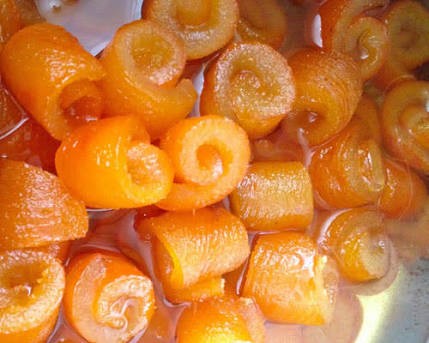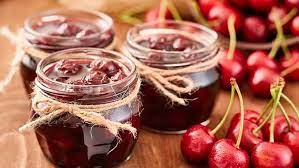Jam Types and Exports of Antalya

In Antalya, famous for its local jams, there is an annual production of nearly 3 thousand tons of jam. Approximately 200 tons of this production exported to more than 30 countries. The most excellent jam types are citrus and bergamot.
The reputation of Antalya jams is based on more than 100 years. Housewives used to offer the citrus, eggplant and, bergamot jams they made at home to their guests. Later, these products started to sell in jars. Thus, the jam types have become a product gaining commercial value in Antalya.
Jam Types
Today, jam made from more than 40 products in Antalya. There is not such a variety of production in Turkey. For this reason, Antalya has become famous for its jams. Bergamot, eggplant, watermelon, green fig, pomegranate, green walnut jam, pumpkin, lemon, grapefruit, chamotte, kumquat are the local jams of this region. These types of jam, especially orange jam, are the symbols of Antalya. The demand for these jam varieties is not limited to Antalya. It is in order from all of Turkey and about 30 countries in the world.
Production Quantities
The total annual jam production in Antalya is 3000 tons. These products are exported to 30 countries. Jams such as citrus, bergamot, eggplant and watermelon go to countries such as America, Australia, Israel, and Dubai. At the same time, products marketed as local products in different cities of our country. Jam varieties are now the favorite of those looking for different flavors.
Organic certified jams are prevalent in America. We use fruit juice instead of sugar in the organic jam. Bergamot is very popular, and they want different aromas and tastes. Orange is in high demand in Israel. In fact, these jams of Antalya introduced to all world leaders at the G-20 summit.
Most Preferred Jam Types : Citrus
 The most famous jam among more than 40 products is the citrus jam. The annual production of citrus jam is about 200 tons. Antalya makes jam from 600 tons of citrus a year. Turunc is easy to find because it is a tree that can stay green for four seasons. Making orange jam is difficult. The citrus fruits are first collected, washed and cleaned. The leaves cut one by one, and the shredded leaves are curled and arranged on the ropes. It takes shape in this state and is then boiled, left to sweeten, and thrown into the bitter water. It takes 25 days to make citrus jam. Since machines cannot use in the production of citrus jam, not everyone can produce it.
The most famous jam among more than 40 products is the citrus jam. The annual production of citrus jam is about 200 tons. Antalya makes jam from 600 tons of citrus a year. Turunc is easy to find because it is a tree that can stay green for four seasons. Making orange jam is difficult. The citrus fruits are first collected, washed and cleaned. The leaves cut one by one, and the shredded leaves are curled and arranged on the ropes. It takes shape in this state and is then boiled, left to sweeten, and thrown into the bitter water. It takes 25 days to make citrus jam. Since machines cannot use in the production of citrus jam, not everyone can produce it.
West Mediterranean Agricultural Research Institute
The West Mediterranean Agricultural Research Institute (BATEM), affiliated with the Ministry of Food, Agriculture and Livestock in Antalya, is one of the most important producers of local jam varieties in Antalya. BATEM, founded in 1933 and conducts scientific research on many fruit and vegetable varieties, especially citrus fruits, produces nearly 50 tons of jam annually.
Antalya is famous for its orange jam. BATEM researched the evaluation of these products as marmalade and jam with a project. As a result, he makes jams from different fruits and vegetables such as citrus, bergamot, fig, tomato, eggplant, kumquat.
Export of Jam Types
 Turkey exported 36 million 818 thousand dollars of jam types, jelly, and marmalade to 135 countries in the 2021 period. According to the information compiled from the records of Uludağ Exporters’ Associations (UIB), 36 million 818 thousand dollars of foreign exchange income obtained in the January-October period from the exports to 135 countries in the said product group.
Turkey exported 36 million 818 thousand dollars of jam types, jelly, and marmalade to 135 countries in the 2021 period. According to the information compiled from the records of Uludağ Exporters’ Associations (UIB), 36 million 818 thousand dollars of foreign exchange income obtained in the January-October period from the exports to 135 countries in the said product group.
Food producers in this area made the highest export sales to Iraq in the January-October period. Exports to this country in 10 months amounted to 6 million 697 thousand dollars with an increase of 6 percent compared to the same period of the previous year. Exports to Saudi Arabia, which is in second place, were recorded as 5 million 100 thousand dollars with a decrease of 1.6 percent.
The exports of the sector representatives to the USA, one of the essential markets, increased by 24.53 percent to 2 million 804 thousand dollars.
Jam, jelly, and marmalade producers exported 2 million 412 thousand dollars to Germany, 2 million 98 thousand dollars to the Netherlands, 1 million 771 thousand dollars to the United Arab Emirates, and 1 million 274 thousand dollars to Belgium.
In the ten months of the year, exports to Denmark increased more than ten times and rose from 49 thousand dollars to 492 thousand dollars.
Exports to Mexico, where 9 thousand dollars of products were sent in the January-October period of last year, increased more than 34 times in the ten months of this year and reached 309 thousand dollars.


